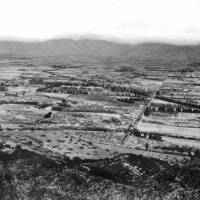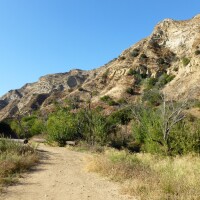Worthy of Love: San Fernando Valley Locals Continue to Rally For Their Portion of the L.A. River

If one were to search for the most lovable part of the Los Angeles River, many would agree that it would at the heart of Elysian Valley. Brimming with greenery and wildlife, this soft-bottomed stretch of the river surrounded by bungalow-type homes is the poster child for a naturalized river.
Here, the promise of a revitalized river is never more tantalizing. So much so, that in the past few years, property values in Elysian Valley have skyrocketed. “Properties that were selling at $300,000 to $400,000 have had offers that go up to $3-4 million. The speculation and pressure on the community is intense,” reports Christine Peters, Policy Adviser for Council District 13 last year. Developers have gone into overdrive, even as residents try to ease on the brakesto retain their way of life.
But the Los Angeles River isn’t just this idyllic, coveted, 10-mile stretch of green; it is 51 miles of waterway that wends its way through many Los Angeles neighborhoods. Eighteen of those miles are concentrated in San Fernando Valley, where, mostly encased in concrete, it weaves through the backyards of schools, apartment complexes, offices, and even an occasional park.

Compared to the lushness of the river in Elysian Valley, the San Fernando Valley stretch can seem desolate and bare. “Over the last twenty years, nobody really paid attention to the river because it was basically a concrete ditch with nothing going on,” says Reseda neighborhood council president Fran Piazza. “Some of the projects like pocket parks got started some ten years ago and nothing ever happened, so the community just said, ‘This is another city project that isn’t going anywhere.’” A decade ago, advocacy for the Los Angeles River was still in its infancy. Like many projects on the Los Angeles River, it would take time to bring together the funding, design process and public outreach to move projects forward.
But that sentiment has been changing, especially in the last few years. “Now that we’re seeing some of the projects come to fruition, it makes the community feel that the river has become more viable,” continues Piazza.
There have been many projects in the Valley, mainly bits of parks. Michael Affeldt from the Mayor’s LARiverWorks office says “Every time a trail project, a greenway, a parkway is built, there is increased connection, attention, understanding of the river.”
It is just the multiplicity of these projects that make it difficult to keep track of and celebrate. The furor of these projects are certainly nothing compared to the excitement engendered by the $1.3 billion plan to restore the river in Elysian Valley, but it is nevertheless not overlooked.
Even as attention is poured on the Elysian Valley, Mayor Eric Garcetti and County Supervisor Sheila Kuehl announced a joint investment of $6 million going toward plugging 12 miles of gaps in the San Fernando Valley portion of the Los Angeles River Valley Greenway. The announcement has further encouraged residents to dream about a greener Los Angeles River in their backyards.


In Studio City, Studio City Neighborhood Council president John Walker says residents that live by the river have always “understood the value of keeping the river alive.” No better example of their forward thinking can be found than in the work of the Village Gardeners, volunteers who green and clean the river at the border of Sherman Oaks and Studio City.
Not only do the gardeners have a passion for keeping their surroundings green, they also understand that more beautiful surroundings means better property values. This concern is essential especially when you consider the residential properties that abut the river.
Studio City residents feel so strongly about keeping the river a natural resource that they have come out against the proposal to develop the Weddington Golf Course. The proposal would turn what is now a serene green space used for tennis and golf into a multi-story senior housing complex. “The position of the greater population of Studio City is against any type of project going in anywhere along the river that does not include the preservation or integration of the L.A. River,” says Walker.
According to Walker, it is not just the current political climate that inspires the residents’ vigor, but the awareness of the larger picture. “The drought has brought water to the forefront of all our conversations. Anyone who has common sense must acknowledge where we are, what the real situation of climate control is about and how very precious water is and will become.”
Like a happy virus, interest in the river has also spread west to Sherman Oaks. “We saw things happening in Studio City and other places and we said, ‘Wait a minute. What about Sherman Oaks?’” recalls Carolyn Casavan, chair of the Sherman Oaks Neighborhood Council’s Green and Beautification Committee. The community interest has also been recorded in a visionfor Sherman Oaks, which Casavan says will be subject to a lot of changes in the coming months.
In Sherman Oaks, there are a few bright spots on the river such as Ernie’s Walk, a grassroots project by a resident. However, “the rest of the river in Sherman Oaks is really unimproved. With no access in some stretches and unofficial access in some,” says Casavan.
It is Casavan’s role to help change that by working with the Mayor’s Office to gain public input on what the Los Angeles River could be in Sherman Oaks. She says the question is harder than it seems. “There are a lot of different opinions and different ways people use the river.”
During an informational tour she took, people’s ideas of “beautiful” meant anywhere from leaving it completely natural with trees and vegetation or intervening, adding benches or beautiful fences.
While waiting for the Mayor’s Office on the long-term vision for the river in San Fernando Valley, Casavan’s team is working on opening up a small walking path and adding handicap access between Hazeltine and Woodman.
Further west in Reseda, neighborhood council president Fran Piazza says residents are no less enthused. “The overall feeling is that the community is ready for multiple uses of the concrete divide we call the LA River.”
After years of hearing about projects, the community is now finally seeing some of them come true. Last November, Reseda saw the groundbreaking for the Los Angeles River and Aliso Creek Confluence Project, which transform a vacant lot into a two-acre park with one mile of walking paths and three-quarter miles of bike path and greenways. More importantly, the project will connect to the whole of the Los Angeles River Greenway.
Ongoing and completed projects like these not only build excitement for river revitalization, but also add to the community’s confidence in the city’s commitment to the river. So much so that Reseda Planning and Land Use committee has approved a $50 million mixed-use project that will sit right on the river, replacing an auto shop.

The plan is for the development’s apartment balconies to face the river. “When we spoke to the developers, they were really happy that it would be on the riverside, even if it’s mostly concrete. I think having it be riverfront was a selling point for their condos and apartments,” says Piazza. Such a project is “groundbreaking” for Reseda, says Piazza and the community hopes that others follow suit with $2 million or $3 million projects that will bring more activity to the neighborhood.
But it isn’t only project completion that needs to be addressed on the river, but safety as well. Piazza notes that because of the gritty concrete nature of the river, the waterway has attracted its share of homeless. Graffiti and trash is also a persistent problem. “If more resources could be directed on a regular basis to combat those concerns, we would then see a much larger adoption of the L.A. River by the community,” he says.
Despite the budding excitement that can be felt for the San Fernando Valley stretch of the river, engagement levels for Los Angeles River revitalization in Elysian Valley is still palpably higher.
There can be many reasons for this. Elysian Valley’s stretch of the Los Angeles River is surprisingly lush and beautiful. This Los Angeles River’s bucolic beauty is one that can be rhapsodized; in the Valley, the river easily melds into the hard urban surfaces of civilization.
It can also be that in the Los Angeles River is an indelible part of the Elysian Valley experience. In this compact, 0.79-square mile neighborhood, the streets end where the river begins. Further north, however, the river ducks beneath freeways and hides behind outsized parks.
Piazza suggests an even more practical reason for this discrepancy: prioritization. The Reseda community is more focused on other city projects that have more immediately available funding and support such as the Mayor’s Great Streets initiative. Currently, there are plans to transform Sherman Way from Lindley to Wilbur into a more multi-modal, active street. “That’s the major focus right now, not necessarily the river,” says Piazza, though he surmises that more emphasis on the river will come when more funding and support becomes available.
However, Piazza adds, “at the end of the day, the community likes what has been done thus far, and they are ready to see the entire riverfront renovated.” Some in Reseda have even suggested an art walk showcasing the work of local artists. Or perhaps parks on both sides of the river connected by bridges.

It remains to be seen if these grand plans would be realized because these community suggestions go further than what is currently planned. The thrust of revitalization in San Fernando Valley is enhancing mobility and connectivity along the Los Angeles River Greenway. “The long term vision for the river is that both sides would be built out complete with walking rails on one side and a bike path,” says Affeldt. “It’s not just about cyclists, though that’s a key thrust of the work, but for a continuous system on both sides.”
The sheer amount of concrete in the northern reaches of the LA river precludes a re-wilding effort, similar to what is proposed for Elysian Valley. But perhaps this disadvantage can be overcome. Some stretches are already blessed with robust tree canopies. In addition, the river isn’t as wide when compared to portions downstream, giving these stretches an even more intimate atmosphere.
It would be many years before the dream of one continuous greenway becomes a reality, but projects are ongoing. The Aliso Creek Confluence Park by the headwaters is in construction. The Cabellero Creek Park is in planning and design. The Veteran’s Park is slowly materializing. And as Affeldt notes, as projects open to the public, the more reasons people have to love the river in their backyard. And for residents who have yet to venture to the river, he says, “Don’t wait. Enjoy the trails and paths that are already there.”
Top image: On the L.A. River in the San Fernando Valley. Photo by Julian Bleecker. Flicker Creative Commons License.





